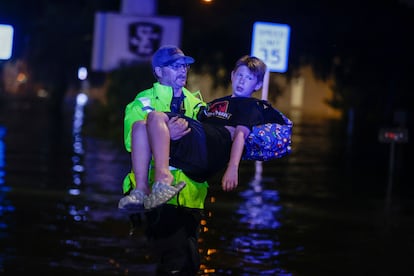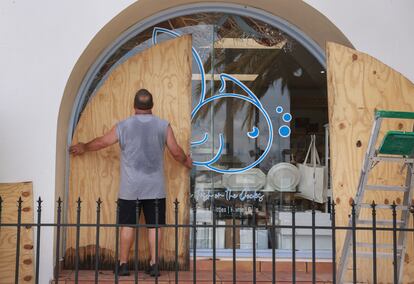Key facts about Hurricane Helene in the United States: Trajectory, category, victims and impact
Now downgraded to a tropical storm, Helene has wreaked havoc across nearly 800 miles, from South Florida to the Appalachian Mountains

Hurricane Helene has weakened as it moved across the Gulf of Mexico toward the northwest coast of Florida. The U.S. National Hurricane Center (NHC) has reported that the storm, which hit the state as a Category 4 hurricane, has been downgraded to a tropical storm. The center warned, however, that the front remains dangerous and that it expects “catastrophic and life-threatening flash flooding,” as well as landslides and burst river banks. Below are the key points about this natural phenomenon and the precautions that residents of the southeast coast of the United States should take.
Helene has wreaked havoc across nearly 800 miles, from South Florida to the Appalachian Mountains, as it moved inland with devastating consequences. Coming ashore as one of the strongest hurricanes to hit Florida, Helene brought intense winds and powerful surf that inundated neighborhoods in the densely populated Tampa Bay area, leaving behind scenes of destruction and despair. Recovery efforts are focused on clearing debris and fallen trees, particularly in the Big Bend region, where residents reported extensive damage reminiscent of the aftermath of a “nuclear bomb.” Emergency services in Pinellas County received an unprecedented volume of 911 calls, conducting hundreds of rescues in response to the flooding.
As Helene continues its path north, the storm has left an estimated 4.5 million people without power across multiple states, exacerbating the risks of heat-related illness as temperatures rise. Flash flood emergencies have been declared in parts of North Carolina, with mandatory evacuations ordered due to dangerously high river levels.
Where could Hurricane Helene impact?
The NHC has reported that Helene is now a tropical storm after hitting the coast of Florida on Thursday night. During the early hours of Friday morning it will advance to Georgia, North Carolina, and South Carolina, where power outages affecting more than two million people have already been reported. The state of emergency has also been extended to Virginia and Alabama.
Authorities had issued warnings for coastal areas, urging residents to complete necessary preparations and evacuate if instructed to do so. Florida Governor Ron DeSantis declared a state of emergency and has ordered response teams to restore power services after the storm passed.
What rank is Helene and what rank could she reach?
Helene is currently a tropical storm; forecasters had warned Thursday that Helene would reach Category 4 status and bring heavy rain and destructive winds along its path. It made landfall Thursday along the Big Bend coast, an area that has experienced several severe weather events in the past year, including Hurricane Idalia and Hurricane Debby. It was downgraded Friday, but maintained damaging wind gusts, with maximums of 110 kilometers (68 miles) per hour.

Hurricane victims
At least 19 people have died as a result of the passage of Helene: Seven in Florida, 11 in Georgia and one in South Carolina. One person died and another was injured in Charlotte, North Carolina, after a tree fell on a house. In Tampa, Florida, one fatality was also reported when a fence hit a vehicle that was on a highway. In Georgia, there were two deaths due to a tornado.
A landslide has affected four homes near the mountains of Asheville, North Carolina, and the residents have reportedly not yet been found. Authorities say workers are still searching for the residents, but have had not yet located them.
Preparations and alerts for the arrival of Helene
Authorities had issued evacuation orders in several areas, especially in Big Bend, where the storm surge was potentially deadly, covering areas with enough water to submerge two-storey homes. The state government had urged residents to seek shelter on higher ground and avoid long drives.
Hours before the hurricane made landfall, the NHC noted that Helene had such a wide wind field that up to 60 of Florida’s 67 counties would experience gusts exceeding 39 miles per hour, with the exception of the western Panhandle. Residents on Florida’s west coast also prepared for the storm, filling sandbags and protecting their properties.
In North Carolina, local officials ordered mandatory evacuations along the Swannanoa River due to expectations that it would reach its highest level ever recorded. A flash flood emergency was issued for Asheville, North Carolina, as forecasters warned of a high risk in the area.
In Georgia, the Fulton County Emergency Management Agency initially warned of the threat of high winds, but later lifted that warning while continuing to urge residents to avoid travel until conditions improved. The region experienced significant rainfall prior to Helene’s landfall, making it more susceptible to flooding.
Sign up for our weekly newsletter to get more English-language news coverage from EL PAÍS USA Edition
Tu suscripción se está usando en otro dispositivo
¿Quieres añadir otro usuario a tu suscripción?
Si continúas leyendo en este dispositivo, no se podrá leer en el otro.
FlechaTu suscripción se está usando en otro dispositivo y solo puedes acceder a EL PAÍS desde un dispositivo a la vez.
Si quieres compartir tu cuenta, cambia tu suscripción a la modalidad Premium, así podrás añadir otro usuario. Cada uno accederá con su propia cuenta de email, lo que os permitirá personalizar vuestra experiencia en EL PAÍS.
¿Tienes una suscripción de empresa? Accede aquí para contratar más cuentas.
En el caso de no saber quién está usando tu cuenta, te recomendamos cambiar tu contraseña aquí.
Si decides continuar compartiendo tu cuenta, este mensaje se mostrará en tu dispositivo y en el de la otra persona que está usando tu cuenta de forma indefinida, afectando a tu experiencia de lectura. Puedes consultar aquí los términos y condiciones de la suscripción digital.
More information
Archived In
Últimas noticias
Most viewed
- Alain Aspect, Nobel laureate in physics: ‘Einstein was so smart that he would have had to recognize quantum entanglement’
- David King, chemist: ‘There are scientists studying how to cool the planet; nobody should stop these experiments from happening’
- Maps of the US attack on Venezuela: Targets, airspace and deployed fleet
- Key points of the military attack on Venezuela: Early morning bombings and a ‘captured’ president
- Mexico completes its trade shift with the entry into force of tariffs on China and countries without trade agreements









































